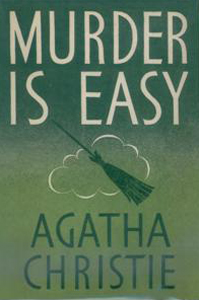“Murder is Easy” (1939), appropriately, is an easy-to-read Agatha Christie novel. It’s like a snack more than a full-course meal. Although it won’t rank on many lists of the elite Christie novels, there’s not much wrong with it. One can nitpick, but those nitpicks don’t detract from the page-turning enjoyment.
Ex-cop finally gets a great case
A retired small-town police officer named Luke Fitzwilliam is our protagonist. It’s odd that he’s a career police officer yet also a novice in murder investigations, and that he comes off as a young fellow in every way. We’re reminded a few times that he is indeed a retired cop, as if Christie needed to remind herself. But I’m OK with it; not everyone needs to fit a mold.
Luke becomes interested in 20-something Bridget, who is engaged to tabloid newspaper magnate Lord Easterfield. Luke is staying at their house (almost like a castle, under Easterfield’s renovations), having agreed – through a mutual friend — that he pose as Bridget’s “cousin of a sort.”

“Murder is Easy” (1939)
Also published as: “Easy to Kill”
Author: Agatha Christie
Genre: Mystery
Series: Superintendent Battle No. 4
Setting: Wychwood under Ashe, United Kingdom
Although featuring a cop and evocatively titled “Easy to Kill” in the American edition, this isn’t a hardboiled pavement-pounder. It’s more akin to a Miss Marple “cozy mystery,” except with a sleuth who is on par with the reader in skill level.
Romance and mystery meet again
Luke isn’t exactly an expert in romance, either. Taking a page from Hastings’ playbook, he’s smitten with every pretty young lady he comes across. Luke decides over a short period of time that he likes Bridget and immediately asks her to marry him.
So, like “The Boomerang Clue,” this is a romance-mystery blend. Christie tries for a bit of a love-hate thing. Luke is so annoyed by some of Bridget’s affectations that he thinks she must have “bewitched” him into liking her. It’s amusing enough, but not exactly a love story for the ages.
Certainly, the mystery holds sway over the romance this time. Luke learns from Miss Fullerton, a random old lady with whom he shares a train compartment, about a string of serial murders in a small town. They are all officially accidents, but Miss Fullerton – a Miss Marple stand-in – intuits otherwise.
But on her way to Scotland Yard to file her suspicions, she’s killed in a hit-and-run. So as in “Dumb Witness” (a.k.a. “Poirot Loses a Client”), Luke aims to solve a mystery armed only with a deceased person’s vague intimations.
Christie staples on display
We get the Christie staples we love, starting with a dramatis personae at the front. Luke thinks about the suspects, and why they might’ve killed each victim, in that way wherein his thoughts are presented as internal speech with quote marks. He makes a written list.

The author peppers in winking meta-humor. One suspect is too obviously suspicious, so – if this were a mystery novel – he definitely didn’t do it. Someone else is too mellow to be a killer, so – if this were a mystery novel – that puts him at the top of the suspect list.
Luke’s interviewees – either suspects or people who can tell him about the suspects – pop with personalities, almost to the point of absurdity. They range from pompous Lord Easterfield to antique dealer Ellsworthy, who oversees pagan orgies in the woods as a hobby!
The dialog is particularly good in “Murder is Easy.” Among my favorites is Luke’s rejoinder to Bridget’s assertion that one suspect “wouldn’t hurt a fly”:
“That may be true. But he certainly killed a canary bird, and I’m pretty certain he’s killed a large number of human beings as well.”
Where’s Marple when we need her?
Because Luke is new to this, I got to thinking “Maybe he’s overlooking someone.” I started to think of everyone as a potential suspect, not just those on Luke’s list. I tried to think like Poirot or Marple. (By the way, “Murder is Easy” is technically a Superintendent Battle book, but his appearance is a glorified cameo.)
“Murder is Easy’s” solution isn’t easy. But it makes for a satisfying final statement about a theme stated from the beginning: Murder is easy if no one has any reason to suspect you, and if you smartly go about each crime.
In the real world, most murders are not pre-meditated, and usually the killer and victim know each other. So “Murder is Easy” is a thought experiment where Christie asks “What if someone plans out murders of people they aren’t connected to? Could they get away with it?”
At the same time, the solution hews close enough to reality to be chilling, and the motive is psychologically fascinating.
Every week, Sleuthing Sunday reviews an Agatha Christie book or adaptation. Click here to visit our Agatha Christie Zone.

